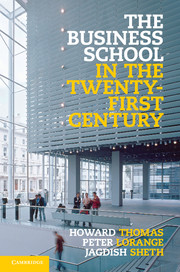Book contents
- Frontmatter
- Contents
- List of figures
- List of tables
- Preface: Tipping or tripping? The business school and its dilemmas
- Acknowledgements
- 1 The business school: history, evolution and the search for legitimacy
- 2 Business school identity and legitimacy: its relationship to the modern university and society
- 3 Rethinking management education and its models: a critical examination of management and management education
- 4 A framework for re-evaluating paradigms of management education
- 5 Evaluating new and innovative models of management education
- 6 Is the business school a professional service firm? Lessons learned
- 7 Enhancing dynamic capabilities in the business school: improving leadership capabilities in curricula and management
- 8 Afterword: business school futures
- Index
- References
1 - The business school: history, evolution and the search for legitimacy
Published online by Cambridge University Press: 05 July 2013
- Frontmatter
- Contents
- List of figures
- List of tables
- Preface: Tipping or tripping? The business school and its dilemmas
- Acknowledgements
- 1 The business school: history, evolution and the search for legitimacy
- 2 Business school identity and legitimacy: its relationship to the modern university and society
- 3 Rethinking management education and its models: a critical examination of management and management education
- 4 A framework for re-evaluating paradigms of management education
- 5 Evaluating new and innovative models of management education
- 6 Is the business school a professional service firm? Lessons learned
- 7 Enhancing dynamic capabilities in the business school: improving leadership capabilities in curricula and management
- 8 Afterword: business school futures
- Index
- References
Summary
INTRODUCTION
Since the 1960s, young, ambitious managers have regarded attending a programme at a high-quality business school as almost a prerequisite for business success and eventual promotion to the executive suite.
More recently, despite business schools being one of the acknowledged success stories of higher education over the past forty years, there has been a wide range of comment and criticism and a growing sense of concern about the value, purpose, role and academic stature of business schools.
There is, for example, criticism about them being too market-driven (Bennis and O’Toole, 2005), about the impact and relevance of business school research (Pfeffer and Fong, 2002) and some doubt about whether attendance at a business school actually makes anyone a better manager (Grey, 2005: 106; Mintzberg, 2004). It is argued that management is an art and not a science (Mintzberg, 2004) and that it is not even a profession since it has no widely accepted body of knowledge, unlike accounting, medicine or law (Spender, 2007).
This chapter, therefore, poses the following questions:
(1) What is a business school? How did it become a commonly accepted model? What is its espoused role and purpose?
(2) How did the business school concept develop?
(3) How has the business school evolved from an historical perspective?
(4) What is the evidence of both success and failure of the business school?
(5) What is its current positioning and strengths/weaknesses?
- Type
- Chapter
- Information
- The Business School in the Twenty-First CenturyEmergent Challenges and New Business Models, pp. 1 - 51Publisher: Cambridge University PressPrint publication year: 2013
References
- 1
- Cited by

